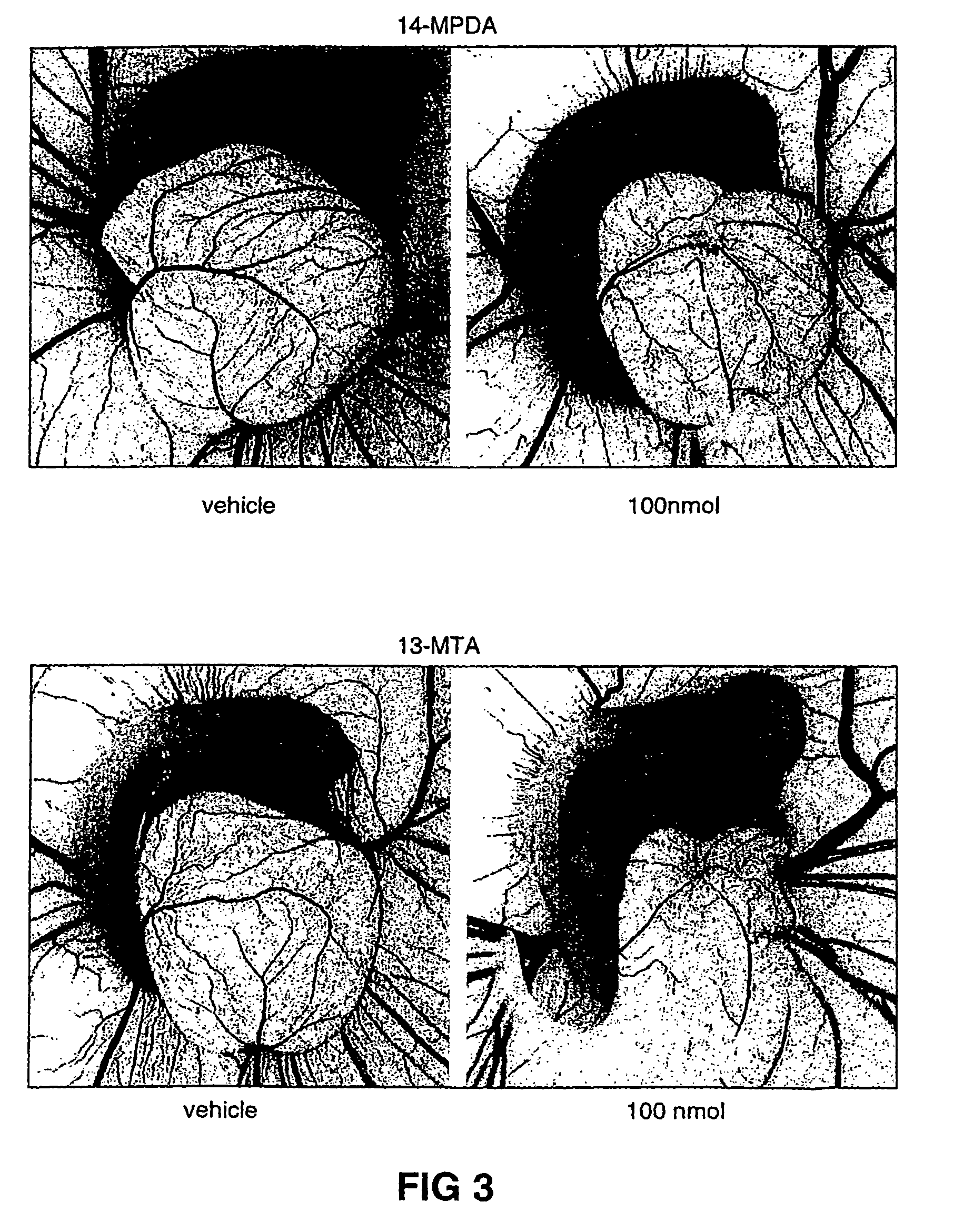Method of inhibiting angiogenesis
a technology of angiogenesis and angiogenesis splicing, which is applied in the field of methods, can solve the problems of uncontrolled or undesired angiogenesis, insufficient blood supply of tumour cells, and damage to the normal function of tumour cells, and achieves significant therapeutic potential, inhibits the proliferation, and reduces the toxicity of alkyl-substituted fatty acids in the assay.
- Summary
- Abstract
- Description
- Claims
- Application Information
AI Technical Summary
Benefits of technology
Problems solved by technology
Method used
Image
Examples
example 1
Preparation of 12-methyltetradecanoic acid (12-MTA) and other alkyl-substituted fatty acids
[0209] 12-methyltetradecanoic acid and other alkyl-substituted fatty acids were obtained from Sigma Chemicals.
[0210] Due to the poor aqueous solubility of 12-methyltetradecanoic acid, the compound was dissolved in 95% ethanol at a stock concentration of 100 mM. Further dilutions were also performed in 95% ethanol and working concentrations for experiments in the range from 25 μM to 800 μM were diluted in culture medium with a final ethanol concentration of less than 0.8%. Control samples with no added agent in the culture medium contained less than 0.8% ethanol.
[0211] Other alkyl-substituted fatty acids were prepared in a similar manner.
example 2
HUVEC Proliferation Assay
[0212] Human umbilical vein endothelial cells (HUVEC) were seeded in 96-well flat bottomed tissue culture plates at a density of 2.5-5×104 cells / well and treated with various dilutions of agents. Cells were cultured in RPMI medium containing 20% FCS, Penicillin / Streptomycin in a 5% CO2 atmosphere at 37° C. After 24 to 48 hours of incubation, cells were pulsed with 1 μCi of tritiated thymidine for 6 hours. The pulsed cells were trypsinised to detach from the wells and then harvested in a TOMTEC Cell Harvester onto glass fibre filters, which were dried and immersed in scintillation fluid and counted in a Wallac Microbeta scintillation counter. The results were reported as mean cpm±SD.
example 3
Effect of 12-MTA on HUVEC Proliferation
[0213] The tritiated thymidine uptake assay demonstrated that HUVEC proliferation was inhibited in a dose response manner at increasing concentrations of 12-MTA (Table 1). Inhibition was expressed as a percentage of control cells that had no added agent.
[0214] At the concentration of 800 μM, microscopic examination of the cells demonstrated the appearance of apoptotic cells. However, at concentrations between 50 to 400 μM, cells demonstrated good viability but thymidine incorporation into the DNA was inhibited, demonstrating the inhibition of proliferation of the HUVECS by 12-MTA. The inhibition ranged from 99% at 800 AM 12-MTA to 13% inhibition at 50 μM 12-MTA
TABLE 1Dose response inhibition of HUVEC proliferation with 12-MTAMTAAverageSTDEVSample 1Sample 2Sample 3% Inhibition800 μM9.02.0117999400 μM12104.71998.01255813837991944.1200 μM15707.72657.518491154351319727.5100 μM17593.02518.820367169631544918.7 50 μM18781.31468.819272199421713013...
PUM
| Property | Measurement | Unit |
|---|---|---|
| chemical formula | aaaaa | aaaaa |
| size | aaaaa | aaaaa |
| body weight | aaaaa | aaaaa |
Abstract
Description
Claims
Application Information
 Login to View More
Login to View More - R&D
- Intellectual Property
- Life Sciences
- Materials
- Tech Scout
- Unparalleled Data Quality
- Higher Quality Content
- 60% Fewer Hallucinations
Browse by: Latest US Patents, China's latest patents, Technical Efficacy Thesaurus, Application Domain, Technology Topic, Popular Technical Reports.
© 2025 PatSnap. All rights reserved.Legal|Privacy policy|Modern Slavery Act Transparency Statement|Sitemap|About US| Contact US: help@patsnap.com



